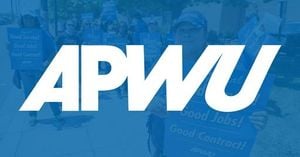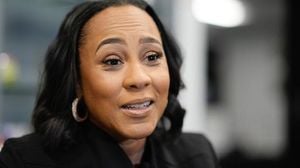On September 12, 2025, the streets of Manhattan’s Financial District pulsed with a renewed sense of urgency as thousands of activists, labor leaders, and community members converged for the March on Wall Street. Organized by Rev. Al Sharpton and the National Action Network, the demonstration drew a broad coalition—including members of the Communist Party USA (CPUSA)—all determined to, as one participant put it, make “good trouble” in the face of what they see as escalating attacks on civil rights, diversity, and the American working class.
This march came just weeks after a quieter milestone: the 62nd anniversary of the historic March on Washington for Jobs and Freedom, which passed on August 28 with little fanfare. But the echoes of Dr. Martin Luther King Jr.’s dream rang loudly through the banners, chants, and speeches in downtown Manhattan. In the words of Dr. Jessica Johnson, a lecturer at The Ohio State University-Lima who reflected on the anniversary, “Although we are two generations removed from King’s moving plea to the nation, we are seeing some of those old, hard-fought battles he mentioned reemerge.”
The central grievances animating the marchers were clear. According to coverage by People’s World, the crowd rallied against what they described as the Trump administration’s “attacks on DEI and affirmative action, its racist mass deportation drive and armed takeover of U.S. cities, and the special targeting of Black mayors.” These policies, they argued, represent a regression in hard-won progress for racial justice and labor rights. The assault on federal workers, collective bargaining rights, voting rights, and public education were likewise among the core issues that brought demonstrators together.
CPUSA members, a visible presence at the march, carried banners and placards specially designed for the occasion. Their message was amplified by allies from the labor movement, civil rights organizations, and faith groups. Many participants saw the moment as a direct response to what they perceive as a coordinated backlash against diversity, equity, and inclusion (DEI) initiatives across the country—an effort they believe is being fueled by big business interests aligned with Trump and the MAGA movement.
Alvin Carter, an organizer with 32BJ, directly addressed the financial powerhouses of Wall Street, saying, “You are the reason that we have folks who aren’t voting for voting rights in the halls of Congress today!” His words underscored a widely held belief among marchers that corporate money is driving policies that undermine democracy and exclude marginalized groups from political and economic participation.
AFSCME President Lee Saunders invoked the memory of Dr. King’s 1963 “bad check” metaphor, recalling how King charged the U.S. with writing its citizens of color a check that came back marked “insufficient funds.” Saunders told the crowd, “That is why we are here on Wall Street today. If anyone has the power to make good on that check, it is the billionaire bankers and big corporations.” The symbolism was potent: Wall Street, long seen as a bastion of wealth and power, was being called to account for its role in perpetuating inequality.
Statistical evidence of persistent discrimination added weight to the marchers’ demands. As Dr. Johnson highlighted in her guest column for The Lima News, two Pew Research Center studies published in May 2025 revealed that 74% of Americans believe African-Americans still face discrimination, 72% say the same for Hispanics, and 66% for Asians. The studies also found that African-Americans are the most likely group to say that more attention needs to be paid to racial issues, and they “remain doubtful about the likelihood of racial equality.” These findings, Johnson wrote, are “somewhat discouraging, considering all the tremendous sacrifices King and those who worked closely with him made in their dauntless fight for social justice during the 1960s.”
The policies of the current administration were a particular flashpoint. Shaylyn Cochran of the Lawyers’ Committee for Civil Rights Under Law pointed out that 300,000 Black women have been removed from the workforce by Trump’s executive orders. Perhaps even more striking, the administration’s cancellation of collective bargaining rights for over 1.3 million federal workers—where Black union members are especially concentrated—was described as “the largest act of union busting in U.S. history.” AFGE President Everett Kelley did not mince words: “When the Trump administration terminated its contract with the unionized workers, it terminated its contract with the American people.”
For many, the rollback of DEI initiatives in the private sector was just as concerning. CPUSA members distributed materials supporting a boycott of Target, a $40 billion retailer that, following Trump’s election, swiftly ended its DEI programs—initiatives originally instituted in response to the massive Black Lives Matter protests of 2020. The boycott, according to People’s World, has led to significant drops in Target’s foot traffic and profits, even resulting in the replacement of the company’s CEO. Rev. Sharpton called on marchers to keep up the pressure, declaring, “If we do not get out and march, if we do not speak up, [Trump] will completely erase the freedoms our parents and our grandparents fought, bled, and died for.”
But the march was not just about policy or economics. It was, at its heart, a call for unity and spiritual renewal. Dr. Johnson reminded readers that the core of King’s vision for equality was “rooted in Godly brotherhood.” She quoted King: “Segregation is a blatant denial of the unity which we all have in Christ Jesus.” Johnson argued that legislative change alone is not enough; genuine progress requires “the genuine love and compassion that God shows,” and a transformation of the heart that transcends the limits of law.
CPUSA co-chair Joe Sims reflected on the day’s events with a historical lens, stating, “Wall Street’s profits, in part, are built on the super-exploitation of African Americans. Not only is there a racist wage differential, but they targeted Black and Brown homeowners during the subprime swindle and made billions. They owe us.” His comments served as a reminder that the struggle for racial and economic justice is deeply intertwined—and that the fight is far from over.
As the crowd dispersed and banners were rolled up, the sense of unfinished business lingered in the autumn air. The march on Wall Street, like the one on Washington generations before, was both a protest and a plea: a demand for justice, a call for solidarity, and a reminder that the dream of equality—spiritual, economic, and social—remains a work in progress.



